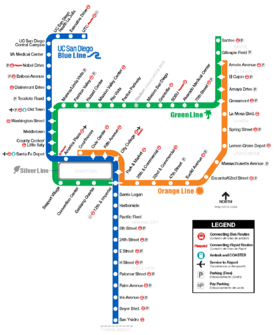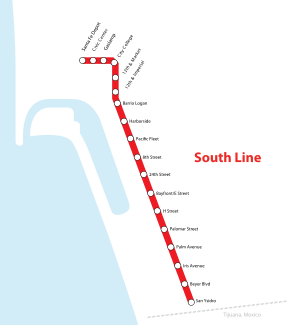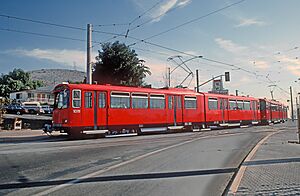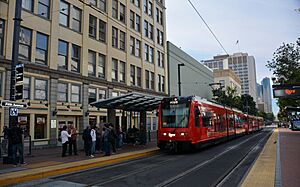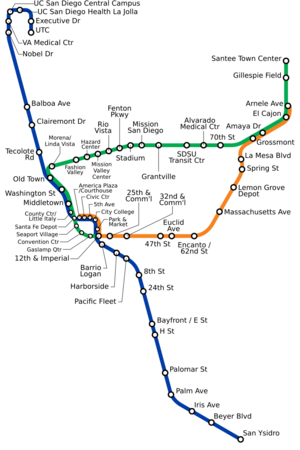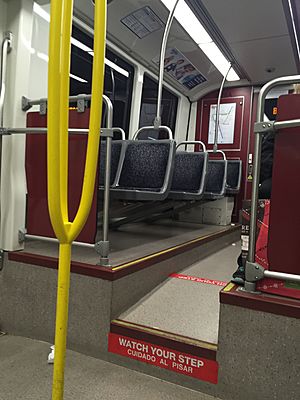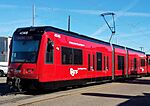San Diego Trolley facts for kids
Quick facts for kids San Diego Trolley |
|||
|---|---|---|---|
 MTSgreenline-convctr.jpg |
|||
| Info | |||
| Owner | San Diego Metropolitan Transit System | ||
| Locale | San Diego County, California, United States | ||
| Transit type | Light rail | ||
| Number of lines | 3, plus 1 limited service heritage streetcar line | ||
| Number of stations | 62 | ||
| Headquarters | James R. Mills Building 1255 Imperial Avenue San Diego, California |
||
| Operation | |||
| Began operation | July 26, 1981 | ||
| Operator(s) | San Diego Trolley, Inc. | ||
| Number of vehicles | 128 light rail vehicles:
3 historic vehicles:
|
||
| Technical | |||
| System length | 65 mi (105 km) | ||
| Track gauge | 4 ft 8 1⁄2 in (1,435 mm) standard gauge | ||
| Electrification | Overhead line, 600 V DC | ||
| Top speed | 55 mph (89 km/h) | ||
|
|||
The San Diego Trolley, often called "the Trolley", is a light rail system in San Diego. It's like a train that runs on tracks, mostly on the street or its own special path. The Trolley is run by San Diego Trolley, Inc., which is part of the San Diego Metropolitan Transit System (MTS). It works closely with local bus systems, and you can even use the same ticket for both!
The Trolley system has 62 stations and covers about 68 miles (109 kilometers). It has three main lines that run every day: the Blue, Green, and Orange lines. There's also a special heritage streetcar line called the Silver Line that uses old-fashioned streetcars on certain holidays. All the main lines connect at one station downtown, making it easy to switch between them.
The San Diego Trolley started running on July 26, 1981. This makes it one of the first modern light rail systems in the United States. In 2019, the Trolley had over 38 million rides, making it one of the busiest light rail systems in the country.
Contents
History of San Diego Trolley
The San Diego Trolley has been serving the city for over 40 years! The MTS has a short history and a longer timeline about it. Before the modern Trolley, San Diego had streetcars that stopped running in 1949. Then, on July 19, 1981, electric trains returned to San Diego streets with the new light rail system.
How the Trolley System Started
Electric rail service in San Diego began way back in 1891 with the San Diego Electric Railway. But by 1949, buses had replaced the streetcars. In the 1960s, people started planning for new public transportation in San Diego. They looked at different ideas, like better buses and various types of rail systems.
In 1975, a plan was made for a new transit system. Then, in the mid-1970s, new laws helped fund transportation projects. A special group called the San Diego Metropolitan Transit Development Board (MTDB) was created in 1976. Their job was to design, build, and run a new transit system. They wanted a system that was affordable, could be built in stages, and used existing land to save money.
The MTDB decided that light rail was the best choice. It could travel fast, fit into different areas, and be built at a low cost. Light rail was new in the U.S. but already popular in Germany.
A Hurricane Helps the Trolley
In 1976, Hurricane Kathleen caused a lot of damage to a railway line called the San Diego and Arizona Eastern Railway (SD&AE). This line was used for freight trains. Because of the damage, the railway company wanted to stop using the line.
The MTDB saw an opportunity! They began to study if the SD&AE line, which ran from Downtown San Diego to San Ysidro, could be used for both electric light rail and freight trains. In 1978, the MTDB bought the SD&AE railway for $18.1 million, after the old company repaired the hurricane damage. This gave the MTDB the land needed for the new trolley lines.
Building the First Line
With the land secured, construction of the first 16-mile (26-kilometer) "South Line" began in December 1979. This line is now part of the Blue Line. The first part of the project cost $86 million. It included buying the railway, 14 light rail vehicles, and building the electric tracks. To save money, they mostly improved the existing railway tracks.
The project was paid for entirely by state sales tax and local gas tax money. No federal money was used at first.
On July 26, 1981, the San Diego Trolley officially started service. Trains ran every 20 minutes and carried about 10,000 passengers each day. Because so many people used it, they quickly started building the second phase. This involved adding a second track to the line and buying 10 more trains. By February 1983, the project was finished, costing a total of $116.6 million.
Growing the System
The San Diego Trolley quickly grew!
- On March 23, 1986, a second line opened, going east to Euclid Avenue. This became part of today's Orange Line.
- This East Line was extended to El Cajon by 1989 and then further north to Santee by 1995.
- The East Line also got an extension to the Convention Center and Gaslamp Quarter in 1990.
- The South Line was extended north to Little Italy in 1992 and Old Town in 1996.
- In 1997, the system expanded east from Old Town with the Mission Valley Line, reaching places like Fashion Valley Mall and San Diego Stadium. At this time, the South Line became the Blue Line, and the East Line became the Orange Line.
On July 10, 2005, the Mission Valley East extension opened. This added the only underground station in the system at San Diego State University and the highest elevated station at Grantville. This new line was named the Green Line. It was also the first line to use new low-floor trolley vehicles, which made it easier for passengers, especially those using wheelchairs, to board.
Trolley System Upgrades
Around the late 2000s, the older parts of the San Diego Trolley needed major updates. The MTS also wanted to use the easy-to-board low-floor trains on all lines.
They got $660 million in funding for the "Trolley Renewal Project." This project included many improvements:
- Stations got bigger shelters, new benches, and digital signs showing when the next train would arrive.
- Old tracks, wires, and power systems were replaced.
- A new signal system was installed.
To use the low-floor trains everywhere, 35 station platforms had to be raised. Also, the new low-floor trains were longer than the old ones. San Diego worked with another city to design a special "Ultra Short" (S70 US) low-floor train that was the same length as the older trains, so they would fit in downtown San Diego.
Between 2011 and 2015, 65 new "Ultra Short" trains arrived. The oldest trains were retired. By 2015, all stations were rebuilt, and low-floor trains could run on all lines.
Blue Line Extension to University City
In 2011, plans were approved for an 11-mile (18-kilometer) extension of the Blue Line. This extension goes north from Old Town to the University City area. It connects to important places like University of California, San Diego (UCSD) and the University Towne Centre shopping mall.
Construction started in 2016, and the Mid-Coast extension opened on November 21, 2021. The Blue Line now serves nine new stations, making it easier for students, hospital workers, and shoppers to use the Trolley.
Current Trolley Service
Trolley Lines
As of 2021, the San Diego Trolley has three main lines that run daily: the Blue, Green, and Orange Lines. These lines cover 65 miles (105 kilometers) of mostly double tracks and serve 62 stations.
There is also the heritage streetcar Silver Line. It runs on certain days in a circle around downtown San Diego, using historic streetcars.
| Line | Opening | Length | Stations | End Points | Operation | |
|---|---|---|---|---|---|---|
| Southern/Western | Northern/Eastern | |||||
| ' | 1981 | 26.3 mi (42.3 km) | 32 | San Ysidro Transit Center, San Ysidro, San Diego |
UTC Transit Center, University City, San Diego |
Daily |
| ' | 1986 | 18.0 mi (29.0 km) | 19 | Courthouse Station, Downtown Core district, San Diego |
Arnele Avenue Station, El Cajon |
Daily |
| ' | 2005 | 23.6 mi (38.0 km) | 27 | 12th & Imperial Transit Center, East Village, San Diego |
Santee Town Center, Santee |
Daily |
| ' | 2011 | 2.7 mi (4.3 km) | 9 | 12th & Imperial Transit Center, clockwise loop around Downtown San Diego |
Selected days | |
Trolley Stations
The San Diego Trolley system has 62 stations. Many of these stations allow you to transfer between different lines. The main transfer point for all four lines is the 12th & Imperial Transit Center station in downtown San Diego. Nearby stations like Santa Fe Depot and America Plaza also connect to all lines.
Most Trolley stations are at ground level. There are 8 stations that are elevated (up in the air), mostly on the Green Line. Only one station, the SDSU Transit Center station on the Green Line, is underground.
About half of the stations have free parking lots where you can leave your car and ride the Trolley. Most stations also connect to MTS bus lines, making it easy to get around.
Hours of Operation
The three main Trolley lines (Blue, Green, Orange) run from about 5 AM to midnight, seven days a week. There is limited service before 5 AM and after midnight. However, there are no passenger trains between 2 AM and 3:30 AM. During these hours, freight trains use the tracks.
Blue Line trains run every 15 minutes, and every 7.5 minutes during busy weekday times. Late at night, they run every 30 minutes. The Green and Orange Lines run every 15 minutes on Monday-Saturday during the day, but every 30 minutes on weekend mornings, Sundays, and evenings.
Fares and Tickets
To ride the San Diego Trolley, you need to have a valid ticket or pass before you get on the train. This is called a "proof-of-payment" system. You can buy one-way paper tickets or passes (for one day or a month) at machines at each station. These are loaded onto a Pronto Card.
Trolley staff sometimes check tickets. If you don't have a valid ticket, you might get a fine. Most people (about 98%) have the correct fare.
A one-way ticket is good for up to two hours from when you buy it. You can transfer to other routes within that two-hour period.
The Pronto Card costs $2. You can add money to it to pay for rides on the Trolley, MTS buses, and other transit systems in San Diego County. The Pronto card uses a "best fare" system. It charges you for each ride, but it won't charge you more than the price of a Day Pass ($6) in one day, or more than a Month Pass ($72) in one month.
You need to tap your Pronto Card on a special validator at the station or scan a QR code from the Pronto App when you enter and transfer.
How Many People Ride the Trolley?
The San Diego Trolley is very popular! In late 2013, about 119,800 people rode the Trolley on an average weekday. This made it the fourth busiest light rail system in the United States.
In 2014, the San Diego Trolley had almost 40 million rides in total. The Blue Line had the most riders, followed by the Green Line, and then the Orange Line. The Silver Line, which runs less often, carried about 29,000 passengers in 2014.
The Trolley's busiest year for total ridership was 2007, with over 36 million rides.
Future Plans for the Trolley
Proposed Airport Extension
One big missing piece in the San Diego Trolley system is a direct connection to the San Diego International Airport. Building this connection is challenging and expensive, but many people want it.
There have been several ideas for how to connect the airport to the Trolley. One idea was a new line connecting the airport to the 12th & Imperial Transit Center and the Old Town Transit Center. While a transit tax to fund this didn't pass in 2020, connecting the Trolley to the airport is still being considered as part of future transportation plans.
Right now, you can take local bus Route 992 from the Santa Fe Depot/America Plaza area to the airport. The airport also has shuttles that stop at the Old Town station and near the Middletown station.
Proposed Purple Line
The Purple Line is a proposed new San Diego Trolley line. It would run from the San Ysidro Transit Center near the U.S.-Mexico border north to Kearny Mesa, with a possible extension to Carmel Valley. This line would mostly follow or be close to the I-805 and I-15 freeways.
Plans for an inland trolley line from San Ysidro to Kearny Mesa have been discussed since 2011. In 2016, a vote to fund the Purple Line did not pass. However, the idea for the Purple Line was included again in future transit plans in 2019, though a funding initiative was not pursued in 2020.
Trolley Fleet
The San Diego Trolley uses trains made by Siemens for its main lines. It also has two special "heritage" PCC streetcars that run on the Silver Line in downtown.
When the system first opened in 1981, they bought 71 high-floor Siemens–Duewag U2 trains. These trains were originally designed for use in Germany. Over time, these older trains were replaced. Some were sold to other cities, and several have been saved in museums.
In 1995, the Trolley bought 52 Siemens SD-100 trains, which were an improved version of the U2. These trains were built in California.
Starting in 2005, San Diego began using low-floor trains, called Siemens S70 vehicles. These trains made it much easier for everyone to get on and off. However, these first low-floor trains were longer than the older ones and could only run on the Green Line.
In 2009, San Diego ordered 65 special Siemens S70 US ("Ultra Short") trains. These trains have the low-floor design but are the same length as the older trains, so they can fit anywhere in the system.
In 2016 and 2019, San Diego ordered more trains, the Siemens S700 US. These have a new design inside with seats along the sides, making it easier for people to move around. These new trains are replacing the older SD-100 trains.
Current Trolley Trains
| Image | Model | Number of Trains | First Bought | Started Service | Notes |
|---|---|---|---|---|---|
| San Diego Trolley fleet | |||||
 |
Siemens SD-100 | 52 | 1993 | 1995 | Being replaced by newer Siemens S700 US trains. |
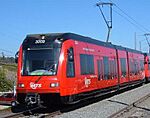 |
Siemens S70 | 11 | 2004 | July 2005 | First low-floor trains in the system. |
| Siemens S70 US | 65 | 2009 | January 2012 | Replaced older Siemens-Duewag U2 trains. | |
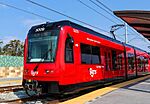 |
Siemens S700 US | 45 | 2016 | April 2019 | Newer trains with updated interior design. |
| 25 | 2019 | November 2021 | Still replacing older Siemens SD-100 trains. | ||
| Silver Line historic fleet (3 trains) | |||||
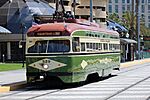 |
PCC streetcar | 2 | 2005 | August 2011 (529) March 2015 (530) |
Historic streetcars used on the Silver Line. |
 |
Siemens-Duewag U2 | 1 | 1979 | July 2019 | The very first type of train bought for the San Diego Trolley. |
Train Details
Here are some technical details about the different types of trains the San Diego Trolley uses:
| Detail | Siemens–Duewag U2 | Siemens SD-100 | Siemens S70 | Siemens S70 US | Siemens S700 US |
|---|---|---|---|---|---|
| Manufacturer | Duewag (with Siemens) | Siemens (California) | |||
| Type | Double-ended train, 6 axles, can link up to 5 cars | ||||
| Height (top to rail) | 12.4 feet (3.8 meters) | ||||
| Center Aisle Floor Height | 39 inches (990 mm) | 15 inches (380 mm) | |||
| Width (outside) | 8.7 feet (2.6 meters) | ||||
| Length (end to end) | 76 feet (23.2 meters) | 76.71 feet (23.4 meters) | 88.5 feet (27 meters) | 79.2 feet (24.1 meters) | |
| Weight (empty) | 77,161 pounds (35,000 kg) | 89,000 pounds (40,370 kg) | 97,900 pounds (44,400 kg) | 96,000 pounds (43,545 kg) | |
| Passenger Capacity | Seated: 64 Total: 150 |
Seated: 64 Total: 150 |
Seated: 68 Total: 200 |
Seated: 60 Total: 150 |
Seated: 58 Total: 150 |
| Doors – 8 per car | High-floor, stairs to board | High-floor, stairs to board | Low-floor, easy boarding | ||
| Wheelchair access | Used a lift (no longer used) | Has ramps at center doors | |||
In addition to these, two historic PCC streetcars from 1946 run on the Silver Line:
- Car 529 has been on the Silver Line since it opened in 2011.
- Car 530 joined the Silver Line in March 2015.
Images for kids
- San Diego Metropolitan Transit System
- San Diego MTS bus system
- Coaster (rail service)
- Sprinter (rail service)
See also
 In Spanish: Tranvía de San Diego para niños
In Spanish: Tranvía de San Diego para niños


